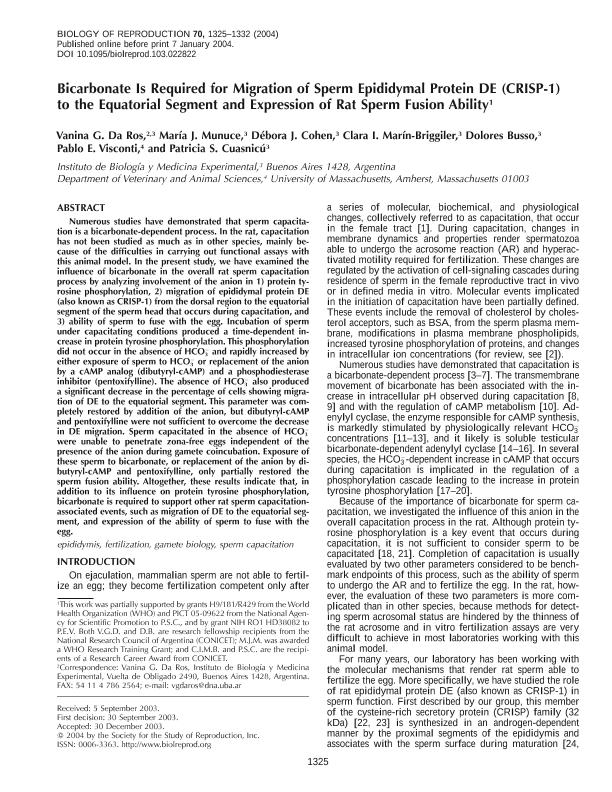Artículo
Bicarbonate is required for migration of sperm epididymal protein DE/CRISP-1 to the equatorial segment and expression of rat sperm fusion ability
Da Ros, Vanina Gabriela ; Munuce, María José; Cohen, Debora Juana
; Munuce, María José; Cohen, Debora Juana ; Marin Briggiler, Clara Isabel
; Marin Briggiler, Clara Isabel ; Busso, Dolores; Visconti, Pablo E.; Cuasnicu, Patricia Sara
; Busso, Dolores; Visconti, Pablo E.; Cuasnicu, Patricia Sara
 ; Munuce, María José; Cohen, Debora Juana
; Munuce, María José; Cohen, Debora Juana ; Marin Briggiler, Clara Isabel
; Marin Briggiler, Clara Isabel ; Busso, Dolores; Visconti, Pablo E.; Cuasnicu, Patricia Sara
; Busso, Dolores; Visconti, Pablo E.; Cuasnicu, Patricia Sara
Fecha de publicación:
05/2004
Editorial:
Society for the Study of Reproduction
Revista:
Biology of Reproduction
ISSN:
0006-3363
e-ISSN:
1529-7268
Idioma:
Inglés
Tipo de recurso:
Artículo publicado
Clasificación temática:
Resumen
Numerous studies have demonstrated that sperm capacitation is a bicarbonate-dependent process. In the rat, capacitation has not been studied as much as in other species, mainly because of the difficulties in carrying out functional assays with this animal model. In the present study, we have examined the influence of bicarbonate in the overall rat sperm capacitation process by analyzing involvement of the anion in 1) protein tyrosine phosphorylation, 2) migration of epididymal protein DE (also known as CRISP-1) from the dorsal region to the equatorial segment of the sperm head that occurs during capacitation, and 3) ability of sperm to fuse with the egg. Incubation of sperm under capacitating conditions produced a time-dependent increase in protein tyrosine phosphorylation. This phosphorylation did not occur in the absence of HCO3- and rapidly increased by either exposure of sperm to HCO3- or replacement of the anion by a cAMP analog (dibutyryl-cAMP) and a phosphodiesterase inhibitor (pentoxifylline). The absence of HCO3- also produced a significant decrease in the percentage of cells showing migration of DE to the equatorial segment. This parameter was completely restored by addition of the anion, but dibutyryl-cAMP and pentoxifylline were not sufficient to overcome the decrease in DE migration. Sperm capacitated in the absence of HCO3- were unable to penetrate zona-free eggs independent of the presence of the anion during gamete coincubation. Exposure of these sperm to bicarbonate, or replacement of the anion by dibutyryl-cAMP and pentoxifylline, only partially restored the sperm fusion ability. Altogether, these results indicate that, in addition to its influence on protein tyrosine phosphorylation, bicarbonate is required to support other rat sperm capacitation- associated events, such as migration of DE to the equatorial segment, and expression of the ability of sperm to fuse with the egg.
Palabras clave:
Epididymis
,
Fertilization
,
Gamete Biology
,
Sperm Capacitation
Archivos asociados
Licencia
Identificadores
Colecciones
Articulos(IBYME)
Articulos de INST.DE BIOLOGIA Y MEDICINA EXPERIMENTAL (I)
Articulos de INST.DE BIOLOGIA Y MEDICINA EXPERIMENTAL (I)
Citación
Da Ros, Vanina Gabriela; Munuce, María José; Cohen, Debora Juana; Marin Briggiler, Clara Isabel; Busso, Dolores; et al.; Bicarbonate is required for migration of sperm epididymal protein DE/CRISP-1 to the equatorial segment and expression of rat sperm fusion ability; Society for the Study of Reproduction; Biology of Reproduction; 70; 5; 5-2004; 1325-1332
Compartir
Altmétricas



